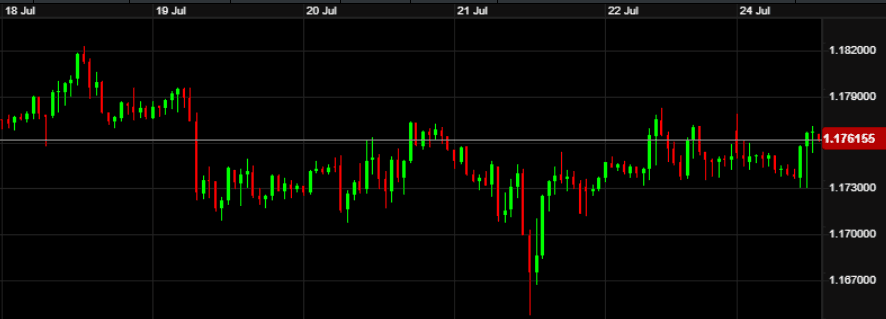ACM Update 25-07-22

Central banks remain in the spotlight in their ongoing battle to tame inflation. The European Central Bank raised rates by half a per cent last Thursday, possibly paving the way for similarly aggressive approaches to come from the Federal Reserve and Bank of England. The former will show their hand this week.
The ECB were certainly the main headline-grabber of last week, with all eyes on Frankfurt on Thursday lunchtime. With Lagarde & co having been very much sat on the fence for some time, their first rate rise since the summer of 2011 has been driven by ongoing inflationary issues.
Having indicated in recent speeches and meetings that there would be a rate rise of 25-basis points last week, the ECB changed tune and went for the more aggressive 50-basis points. This approach was looking more and more like the required action over recent weeks, with other central banks around the world making big hikes. Notably the Bank of Canada pulled the pin so to speak, a few weeks ago.
Elsewhere in Europe. Mario Draghi’s time as the Italian Prime Minister came to an end on Thursday, with what seemed like an inevitable resignation. The coalition government he led has become fractured in recent weeks. Draghi will remain as caretaker prime minister until a new leader is elected in September (this all sounds very familiar). The move could cause further uncertainty in the south of the Eurozone.
For the northern half of the bloc there was good news with the Nord Stream 1 pipeline continuing to flow normally again after routine maintenance. It was estimated last week that any disruption to the pipeline throughout the winter months, could lead to as much as a 1.5% drop in German GDP alone.
Overall, considering the rate hike from the ECB and the political turmoil in Italy, the Euro had a somewhat stable week. Against the Dollar, we moved back away from the parity level by as much as 2.5% at times, before settling circa 1.0200. For GBP-Euro, a relatively flat week as shown in the chart below:

On the UK side of the equation, inflation hit the headlines again this week with a figure of 9.4%, fractionally above expectations of 9.3%. With the Bank of England Governor Andrew Bailey suggesting last week that a 50-basis point rate hike is an option for the next policy meeting (4th August), we could well see some bold action on home soil too.
Has inflation flattened out yet in the UK? Tough to say still. On one hand the last three months have seen figures 9.0%, 9.1% & 9.4% respectively, so this seems to show a flattening curve. Equally oil and thus fuel prices beginning to fall will be a helpful factor. However, there is still concern that the next rise in the energy price cap coming in October will push inflation even higher. This would be in line with the Bank of England’s own suggestion that we would see double-digit inflation at some point this year.
Elsewhere, retail sales slowed in June with -0.1% recorded. Admittedly, this was fractionally better than the -0.2% forecast, so largely snuck under the radar, however is probably a shade disappointing for a month featuring a bumper Jubilee weekend of bank holidays and the associated spending. Fingers crossed this is not a sign of slowing consumer spending, caused by interest rate hikes and cost of living increases.
One other point of note from last week in the UK was the sizeable increase in public sector net borrowing costs, essentially how much it costs the government to borrow money. This brought a spotlight onto the race to be the next Prime Minister, which is now down to Rishi Sunak and Liz Truss. The latter’s economic policies are causing concerns, in terms of her pledge for “immediate and substantial tax cuts”. With the cost of borrowing increasing, she has been viewed less favourably by some financial markets. Sunak won the previous round of voting, with Truss second and Penny Mordaunt eliminated.
For GBP, a relatively quiet week all round despite all of the above, trading fairly flat versus the Dollar either side of 1.20. That said, for Dollar sellers you are still a full 12% to the good in the last five months, sizeable gains indeed. Do consider locking in those gains if you have Dollars to sell at the moment. The movements since the start of the year can be seen in the chart below:

Having been the powerhouse of the year so far, the Dollar had a much quieter week last week with little market data releases of note. If anything, the larger-than-expected interest rate hike from the ECB was the most significant event for the US. With a Fed meeting this Wednesday, we now expect to see a 75-basis point rate hike from Powell & co, somewhat encouraged by bigger than originally expected hikes in Canada and Europe of late.
This week:
Wednesday – Federal Reserve interest rate announcement (19:00 UK time) & press conference (19:30)
Friday – UK Mortgage Approvals (09:30), Eurozone CPI flash estimate exp 8.7% (10:00)
So a thinner week ahead in terms of market events, but the Federal Reserve will be as widely anticipated as they come. A sizeable rate hike will almost certainly force the hand of the Bank of England to follow suit the following Thursday.
Dollar sellers should keep a close eye on rates and make good use of the prices as they are at present. Do reach out to the team with anything you wish to discuss.
Have a great week.